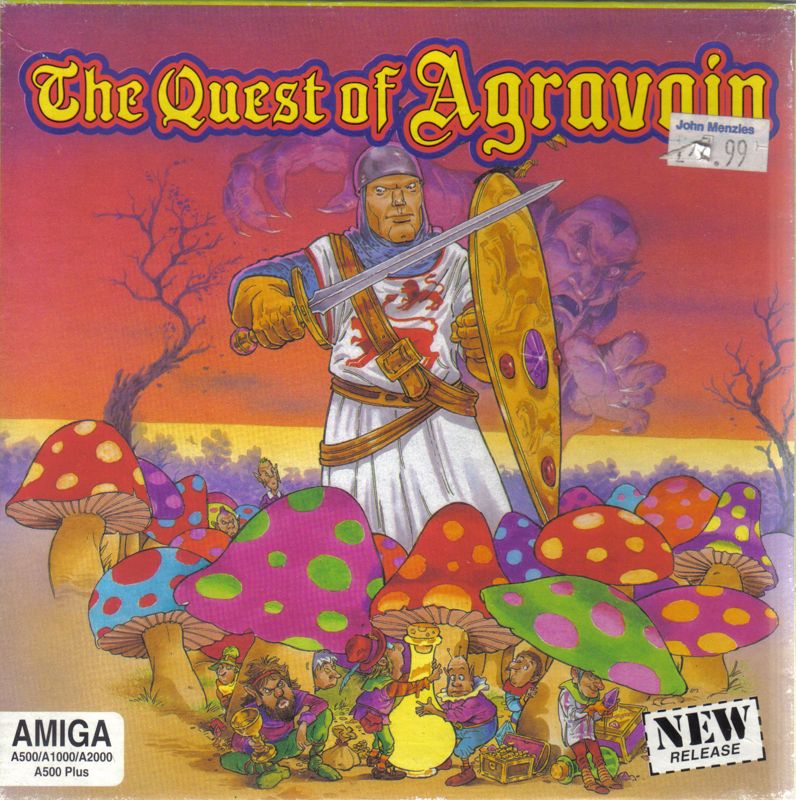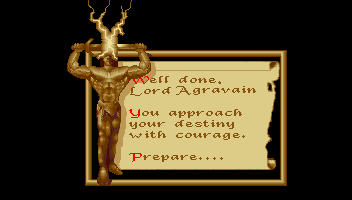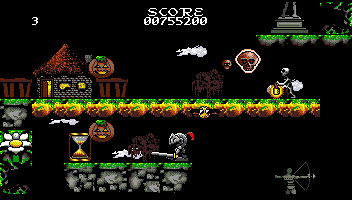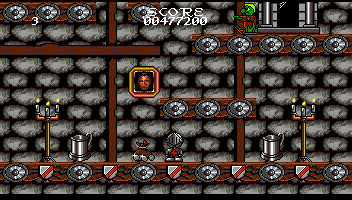Retro Replay Review
Gameplay
The Quest of Agravain delivers a classic platforming experience that will test both your reflexes and your patience. You guide Lord Agravain through increasingly challenging stages, each filled with precarious jumps, hidden traps, and relentless foes. Movement is responsive, and Agravain’s animations convey both weight and agility—important for gauging those split-second leaps across bottomless pits or onto narrow ledges.
(HEY YOU!! We hope you enjoy! We try not to run ads. So basically, this is a very expensive hobby running this site. Please consider joining us for updates, forums, and more. Network w/ us to make some cash or friends while retro gaming, and you can win some free retro games for posting. Okay, carry on 👍)
Combat revolves around two core actions: pressing the fire button to thrust your sword and combining fire with the down direction to toss a small lance. This dual-weapon system encourages tactical play, as certain enemies are easier to dispatch with a ranged lance throw, while others demand close-quarters sword strikes. Timing is critical—attack too early or too late, and Agravain finds himself vulnerable to counterstrikes.
Much like Ghosts ’N Goblins, hit detection is unforgiving. A single hit strips Agravain of his armor, leaving him in nothing but his undergarments, and a subsequent blow means instant death. This high-risk mechanic adds a thrilling tension to every skirmish, but it can also feel punishing for newcomers. Fortunately, power-ups such as crosses that paralyze enemies and stars that grant temporary invincibility can turn the tide—if you can reach them.
With four distinct sets of levels and no save or password system, The Quest of Agravain demands repeated playthroughs and mastery of each section. You start with three lives per run, and each death sends you back to the beginning of the current stage. For dedicated players, this offers a satisfying loop of learning patterns, refining strategies, and celebrating hard-earned progress.
Graphics
The Quest of Agravain embraces the pixel-art aesthetic of its era, delivering richly detailed environments that evoke a medieval tapestry. Stone castles, moss-covered forests, and fiery dungeons are brought to life through carefully crafted tilesets and parallax backgrounds. Each new area introduces fresh color palettes and thematic elements, ensuring visual variety across the four level sets.
Character sprites are equally impressive. Lord Agravain’s armor gleams with metallic highlights, and his limp in “semi-nude” mode—after losing his armor—is both humorous and distinctive. Enemy designs range from skeletal warriors to winged gargoyles, each animated with surprising fluidity. Even minor hazards, like swinging blades or collapsing platforms, are conveyed with clear, expressive frames that telegraph danger.
Subtle visual cues aid gameplay: a flicker in a stone block might hint at a hidden passage, while the shimmering aura around power-ups makes them hard to miss at a glance. The game’s limited palette never feels drab; instead, it captures the grim grandeur of Riva under siege. On more powerful hardware, the backgrounds scroll smoothly, maintaining immersion even in the most frenetic sequences.
While modern gamers might find the resolution modest by today’s standards, there’s a timeless charm in The Quest of Agravain’s artistry. It stands as a testament to how thoughtful pixel work can deliver atmosphere and clarity without overwhelming the screen with superfluous detail.
Story
At its heart, The Quest of Agravain is driven by a simple yet compelling premise: Lord Agravain must secure the fabled Elixir of Youth to save Riva’s aging knights. The narrative unfolds in brief interludes between level sets, each page of text accompanied by evocative illustrations that hint at the stakes and the perils to come.
Though the story doesn’t unravel through lengthy cutscenes or dialogue trees, it fuels your motivation. You feel the weight of Agravain’s mission when you step foot into each new environment—whether you’re venturing into a haunted monastery or scaling the battlements of an ancient fortress. The promise of restoring vitality to the realm drives you to press on, despite the punishing difficulty curve.
Subtextual details enrich the lore: inscriptions on crumbling walls, cryptic runes near hidden power-ups, and the changing mood of the soundtrack. The minimalistic approach means you fill in many gaps with your own imagination, creating a personal connection to Agravain’s quest. This is storytelling by implication, and it works remarkably well in a game built around action.
By the time you face the final challenges, there’s a genuine sense of accomplishment—not just because you’ve honed your platforming skills, but because you’ve lived the knight’s journey. The Quest of Agravain proves that grand narratives don’t always need dialogue-heavy exposition; sometimes all it takes is a sword, a mission, and a vividly realized world.
Overall Experience
The Quest of Agravain stands as a shining example of old-school platforming wrapped in a medieval fantasy setting. Its deliberate difficulty curve and rigorous level design reward players who relish a challenge. Casual gamers, however, should be prepared for moments of frustration, especially given the lack of save points and the strict three-life limit per run.
Replay value is high, thanks to hidden passages, optional power-ups, and the desire to perfect each stage. Speedrunners and completionists will find much to love in the pursuit of flawless runs, while newcomers may appreciate simpler achievements like simply reaching the exit door. Either way, the game fosters a satisfying loop of trial, error, and mastery.
Musically, the score complements the visuals and gameplay, striking a balance between somber medieval themes and adrenaline-pumping motifs. The sound effects—clashing swords, the clang of armor, and distant monster cries—immerse you further into the perilous land of Riva.
For fans of retro platformers and those seeking a demanding adventure, The Quest of Agravain is a worthy contender. It may not hold your hand, but it invites you into a world where every victory feels hard-won and every secret passage discovered is a triumph. If you’re ready for a knightly challenge, your quest awaits.
 Retro Replay Retro Replay gaming reviews, news, emulation, geek stuff and more!
Retro Replay Retro Replay gaming reviews, news, emulation, geek stuff and more!









Reviews
There are no reviews yet.